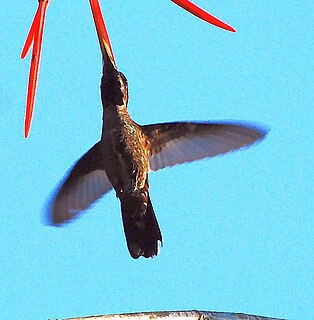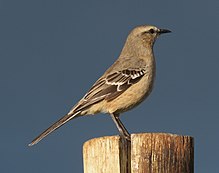
The green-backed firecrown is a hummingbird in the "coquettes", tribe Lesbiini of subfamily Lesbiinae. It is found in Argentina, mainland Chile, and the Juan Fernández Islands.

The plain-capped starthroat is a species of hummingbird in the "mountain gems", tribe Lampornithini in subfamily Trochilinae. It is found from Mexico to Costa Rica.

The orange-throated sunangel is a species of hummingbird in the "brilliants", tribe Lesbiini of subfamily Lesbiinae. It is found in Colombia and Venezuela.

The purple-throated sunangel is a species of hummingbird in the "brilliants", tribe Lesbiini of subfamily Lesbiinae. It is found in Ecuador and Peru.

The white-sided hillstar is a species of hummingbird in the "coquettes", tribe Lesbiini of subfamily Lesbiinae. It is found in Argentina, Bolivia, Chile.

The black-streaked puffbird is a species of near-passerine bird in the family Bucconidae, the puffbirds, nunlets, and nunbirds. It is found in Bolivia, Colombia, Ecuador, and Peru.

The crescent-chested puffbird is a species of near-passerine bird in the family Bucconidae, the puffbirds, nunlets, and nunbirds. It is endemic to Brazil.

The caatinga puffbird is a species of bird in the family Bucconidae, the puffbirds, nunlets, and nunbirds. It is endemic to Brazil.

The Cuban nightjar, is a species of nightjar in the family Caprimulgidae. It is endemic to Cuba.

The rufous-banded owl is a species of owl in the family Strigidae. It is found in Bolivia, Colombia, Ecuador, Peru, and Venezuela.

The tropical screech owl is a small species of owl in the family Strigidae. It is found in Costa Rica, Panama, Trinidad, and every mainland South American country.

The spot-winged pigeon is a species of bird in the family Columbidae. It is found in Argentina, Bolivia, Brazil, Chile, Paraguay, Peru, and Uruguay.

The grey-breasted wood wren is a species of bird in the family Troglodytidae. It is found from Mexico to Bolivia.

The brown-backed mockingbird is a species of bird in the family Mimidae. It is found in Argentina and Bolivia.

The white-banded mockingbird is a species of bird in the family Mimidae. It is found in Argentina, Bolivia, Brazil, Chile, Paraguay, and Uruguay.

The sooty-headed wren is a species of bird in the family Troglodytidae. It is found in Colombia and Panama.

The Surucua trogon is a species of bird in the family Trogonidae, the quetzals and trogons. It is found in Argentina, Brazil, Paraguay, and Uruguay.

Longuemare's sunangel is a species of hummingbird in the "brilliants", tribe Lesbiini of subfamily Lesbiinae. It is found in Colombia and Venezuela.

The Mérida sunangel is a species of hummingbird in the "brilliants", tribe Lesbiini of subfamily Lesbiinae. It is endemic to Venezuela.

The Chaco puffbird is a species of bird in the family Bucconidae, the puffbirds, nunlets, and nunbirds. It is found Argentina, Bolivia, Brazil, and Paraguay.























